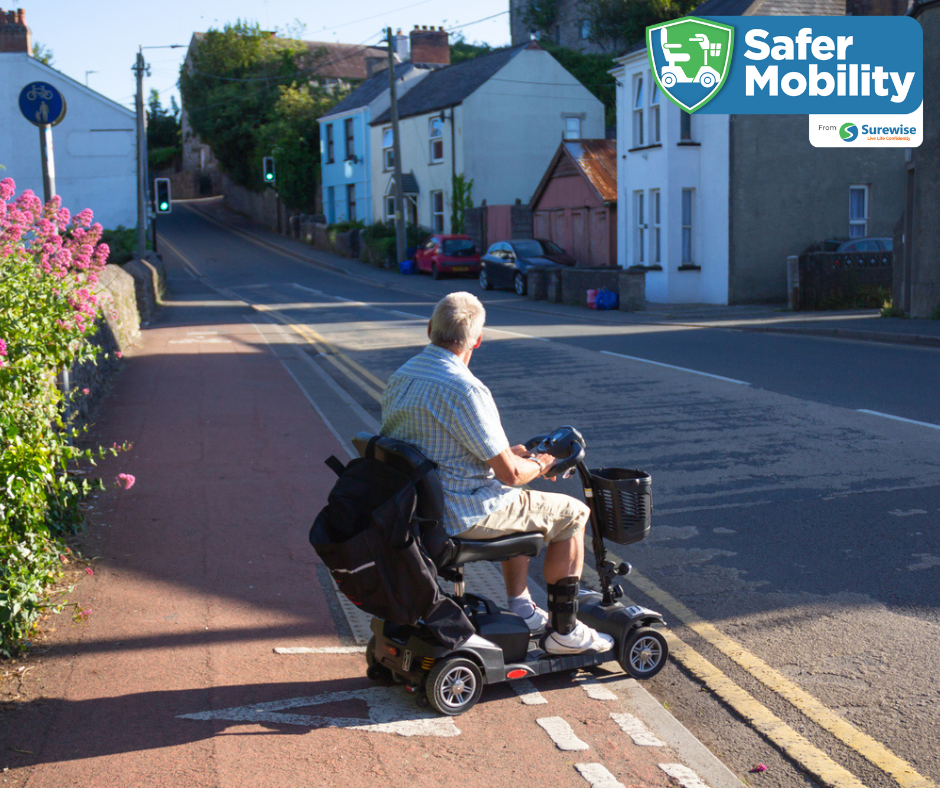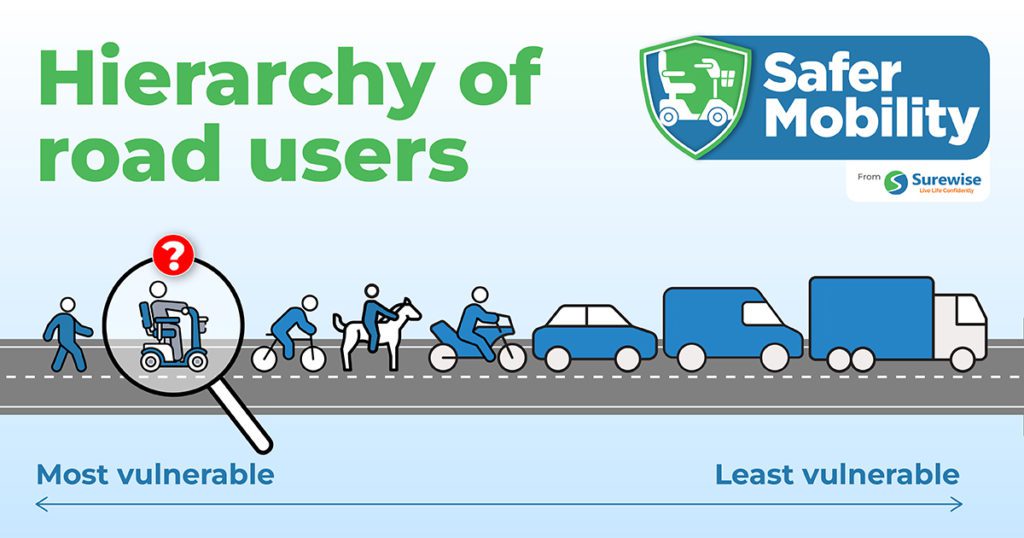Protecting Mobility Scooter Users in the UK
People from all walks of life can suffer from mobility problems that make it difficult to live the lives the rest of us take for granted. Mobility scooters offer a lifeline to many, yet their riders continue to suffer fatalities at an alarming rate.
That’s why Surewise, a specialist mobility scooter insurance intermediary, is determined to change this by calling for mobility scooters to be included in the Highway Code.
“Mobility scooter users are among the most vulnerable people on our roads, yet their unique needs are often overlooked. The fact that their exclusion from the Highway Code persists while fatalities rise is simply unacceptable. Their safety and prioritisation must be reflected in road safety policies.” – Richard Hannan, Director, Surewise.

Why This Matters
The Department for Transport (DfT) road casualty data has revealed that 16 mobility scooter users were killed and 80 were reported seriously injured in collisions in 2023, this is up from nine fatalities and 64 serious injuries in 2022. Add in the fact that virtually every other group saw either a decrease or no change at all in fatalities and you see that mobility scooters have been overlooked for too long.
Research by Richard Hannan and his team at Surewise has highlighted that mobility scooter users are nearly three times more likely to be killed in a road collision than any other road user group.
The Scale of the Problem
In the last 10 years, casualties involving mobility scooters have increased by an average of 20% per year.
In 2023 alone:
- 74% of mobility scooter crashes involved one other vehicle
- In 79% of injury collisions, the mobility scooter user was the victim
- 64% of mobility scooter user casualties were over the age of 55
- 80% of mobility scooter casualties occurred in urban areas
- 23% of mobility scooter-related accidents were caused by either the driver or rider failing to look
- Hurried behaviour (9%), failure to judge another road user’s speed (8%), loss of control (7%) and poor manoeuvres (6%) were other contributory factors
Professor Duncan Guest, an expert in cognitive psychology at Nottingham Trent University, has been at the helm of a pioneering two-year study looking at how mobility scooter users perceive road hazards.
“The significant rise in fatalities and serious injuries involving mobility scooter users underscores the urgent need for their inclusion in the Highway Code. These users face unique challenges navigating pavements and roads, often contending with inadequate infrastructure, poor driver awareness, and a lack of clear guidance.
“By including mobility scooter users in the ‘Hierarchy of Road Users,’ we can ensure their vulnerabilities are recognised and that road safety measures are designed to protect them. Addressing this policy gap is essential to prevent further tragedies and support safer mobility for all.” – Professor Duncan Guest
What is Changing?

The Highway Code was updated back in 2022 to include a hierarchy of road users. Those in vehicles that can do the greatest harm must accept more responsibility during situations that arise on the roads. The problem is that mobility scooter users, many of whom are vulnerable, have been left out of the hierarchy entirely.
Richard Hannan and Surewise are currently leading calls for change while also putting in place a series of other measures to protect this vulnerable group of road users. To date, Surewise has insured over 130,000 mobility scooters and is very proactive in its efforts to reach as many scooter riders as possible.
They have also launched a ‘safer mobility’ campaign that has already gained national support from the police, local authorities, and Nottingham Trent University. By targeting the ‘outdated terminology’ in UK legislation that describes mobility scooters as ‘invalid carriages’, they hope to drive change from the top down.
“This archaic term not only fails to reflect the reality of modern mobility aids but also perpetuates confusion and misunderstanding about their proper use and rights on pavements and roads. Such language undermines efforts to raise awareness and improve safety for mobility scooter users.” – Richard Hannan
Stay Safe on Your Mobility Scooter : UK rules
Follow these tips to stay safe on roads and pavements.
1. Be Seen by Others
- Wear bright or reflective clothes, especially at night or in bad weather.
- Attach reflectors and LED lights to your scooter.
- Use a safety flag on your scooter. It makes you more visible to drivers and pedestrians.
- Consider a helmet with built-in lights for extra safety.
2. Follow the Rules for Pavements and Roads
On Pavements:
- If you have a Class 2 scooter (speed limit 4 mph), you should use pavements whenever possible.
- If there is no pavement, be extra careful on the road.
On Roads:
- If you have a Class 3 scooter (speed limit 8 mph), you can use the road.
- Class 3 scooters must be registered with the DVLA and must have front and back lights, indicators, a horn, and mirrors.
- Stay on the left-hand side of the road. Avoid roads with fast traffic.
- Always cross roads at pedestrian crossings or dropped kerbs.
- Obey traffic signs and signals, just like other road users.
- If you use a dual carriageway (with a speed limit of 50 mph or less), you must have a flashing amber beacon on your scooter.
3. Keep a Safe Speed

- Do not go too fast, especially in crowded areas.
- The legal speed limits are:
- 4 mph (6 km/h) on pavements
- 8 mph (12 km/h) on roads (Class 3 scooters only)
- Use the speed limiter switch on Class 3 scooters to stay within limits.
- Slow down when turning corners, going through tight spaces, or moving around people.
4. Be Aware of Your Surroundings
- Look both ways before crossing roads or driveways.
- Watch out for parked cars, cyclists, and pedestrians. They may not see you.
- Do not use your phone while moving. Stay focused.
- Consider adding rear-view mirrors to your scooter. This helps you see what is behind you.
5. Take Care of Your Scooter
- Check your scooter before each trip:
- Brakes
- Tyres
- Battery levels
- Lights and indicators
- Keep your scooter in a dry and safe place when not in use.
- If you have pneumatic (air-filled) tyres, use tyre sealants to prevent punctures.
6. Plan Your Route
- Use paths with smooth pavements, dropped kerbs, and pedestrian crossings.
- Avoid places with heavy traffic, steep hills, or narrow paths.
- Use mobility apps or council maps to find the safest routes.
7. Use Extra Safety Accessories
- Anti-tip wheels – Stop your scooter from tipping over on bumpy ground.
- Weatherproof cover – Protects your scooter from rain and cold.
- Personal alarm or whistle – Helps in emergencies.
- Helmet – Not required by law, but good for extra safety on the road.
- Lock – Secure your scooter if you leave it outside.
Important UK Rules to Remember
- Class 3 scooters must be registered with the DVLA.
- You do not need road tax, but getting insurance is a good idea.
- You cannot use your scooter on motorways or cycle lanes.
- You cannot use fast dual carriageways unless you have an amber beacon.
By following these safety tips, you can ride your mobility scooter with confidence while keeping yourself and others safe.
Explore More on Disability Horizons
At Disability Horizons, we are committed to raising awareness of the difficulties that those with mobility issues encounter daily. Our ever-expanding library of articles and online resources can provide plenty of additional information for those who want to take a closer look.
Popular articles on the subject include:
- Our guide for new wheelchair users — covering 10 products designed to restore independence
- Our guide on how to choose the right stairlift — covering the key things you need to consider when making your choice
- A first look at a new accessible shower — a product designed to help those with mobility issues remain independent
If you have a story to share or want to contribute to this important conversation, we’d love to hear from you!
About Richard Hannan
Richard Hannan is the Director of Surewise, a specialist mobility scooter insurance intermediary designed to protect vulnerable road users. He is a passionate advocate for the rights of those with mobility issues and other disabilities and is actively campaigning for the removal of unhelpful, outdated wording from UK legislation.

